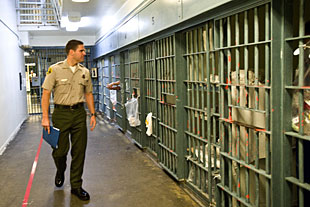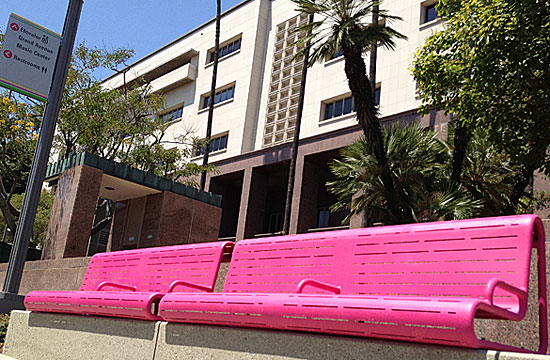Here’s government for the people
July 17, 2012

The CalFresh Mobile Unit will be at Government Day, along with representatives from 39 other agencies.
People don’t always have time to research everything their government does. For example, only half of the Los Angeles County families that qualify for CalFresh food stamps are actually enrolled in the program. This Saturday in the northeast San Fernando Valley, Government Day will give residents a chance to learn what’s out there—and how to put it to work for themselves and their families.
Representatives from 40 agencies will be on hand, including the Los Angeles County Department of Human Resources, which will have applications for county government jobs; the City of L.A.’s Department of Building and Safety, with information on how to report housing issues; and Access Services, which provides transportation for the disabled. Also participating will be the CalFresh Mobile Unit, offering applications for food assistance; the City of L.A.’s Bureau of Street Services, with tips on how to report potholes and other road or sidewalk problems; and the Northeast San Fernando Worksource Center, which will provide applications for its job training programs.
Government Day has been held annually for the past 31 years. This year’s event takes place on Saturday, July 21, from 10 a.m. to 2 p.m. inside the Panorama Mall at 8401 Van Nuys Boulevard.
Posted 7/17/12
A Universal win-win
July 17, 2012
 Back in the 1950s and ‘60s, Los Angeles watched as 20th Century Fox Studios’ massive backlot was gobbled up by the development that eventually turned into Century City.
Back in the 1950s and ‘60s, Los Angeles watched as 20th Century Fox Studios’ massive backlot was gobbled up by the development that eventually turned into Century City.
By now we’re all familiar with that growth and the congestion that followed. Less visible to the public at large was the virtual disappearance of one of Hollywood’s most essential resources: the backlots and production facilities underpinning our hometown industry.
When I was first elected to the Los Angeles City Council, representing Century City, among other communities, I often thought about the loss of the Fox backlot, and all of the jobs and history that went with it.
In recent months, we’ve found ourselves in precisely the same situation. NBCUniversal, one of the last studios in town that actually has a huge working backlot, was proposing to spin off a good chunk of that valuable and historic acreage to build nearly 3,000 apartments and condos.
It’s something I’ve opposed from the start.
Putting thousands of new residents right on the often-noisy frontlines of entertainment production makes no sense. Not only does it detract from Universal’s core mission, it also makes it all but inevitable that the new residents’ complaints about the noise and distractions of making movies and TV would eventually derail that part of the business altogether.
That’s not an insignificant loss to our shared culture and economy. After all, you can build residential units just about anywhere, but once you eliminate a studio backlot, it’s gone forever. And so are the jobs it supported.
Universal’s Evolution Plan, a 20-year guide to the future of the world-famous studio and theme park property, was originally drawn up when the company was still owned by General Electric. Now it has a new majority owner, Comcast, a media giant in its own right. It seems to me that this company is not in this for the quick buck; they’re in it for the long haul.
So in January, I appealed to Universal president Ron Meyer to drop the housing component of the plan. Eliminating a major section of the backlot, I said, would chase away much-needed entertainment jobs from the immediate area and likely hurt his company and our regional economy along with it. Others, including City Councilman Tom LaBonge and many members of the community, added their voices to the opposition.
This week, we had a breakthrough. After receiving numerous public comments and seeing the results of the environmental review, NBCUniversal scrapped its residential building plans. Instead of a quick real estate play, the studio is looking to enhance its core entertainment business, creating potentially more than 30,000 jobs while expanding its production facilities and revamping theme park attractions.
If you’re the grip, tour guide or construction worker who’ll be getting one of those jobs today or in the future, that’s great news. It’s also great news for the broader entertainment industry, which increasingly is turning to Universal as one of the few large-scale production facilities left in town. Building condos would have led to some construction jobs, yes, but those jobs would have disappeared when the last nails were hammered. Entertainment industry production jobs will continue as long as this town still makes movies and TV shows.
But that work can’t exist unless there’s a workplace to go to. And sad to say, studio backlot space is an endangered species these days in Los Angeles. While it might sound strange to an outsider, in our town these are industrial lands devoted to producing to an internationally sought-after product, and it’s vital that we protect them for this creative and economic purpose. Universal’s plan as it stands now does this.
There’s still a long road ahead, as the Evolution Plan moves from the final environmental report phase into a series of public hearings and official reviews that will be required before the first shovels break ground. Neighborhood input has been essential so far, and community voices will continue to be heard as the process moves forward.
It’s important to take a moment now, though, and acknowledge those who’ve realized that taking the long view isn’t just the right thing to do—it’s also good for business.
To his credit, Universal’s Ron Meyer and studio owner Comcast were willing to listen—and courageous enough to ask for a rewrite.
The resulting breakthrough gives our hometown—and our hometown industry—a chance to grow and thrive. This time around, unlike decades ago, the studio, local leaders and the community are taking the long view, and that’s good for all of us.
Posted 7/17/12
A “new day” for First 5 LA
July 17, 2012
It has been less than a year since Los Angeles County threatened to take over First 5 LA.
Created by voters to channel tobacco-tax revenues into programs for babies, toddlers and preschoolers, the independent agency had been accused of sitting on more than $800 million. A scathing audit had accused the organization of mismanagement and overstaffing. Meanwhile, much-needed initiatives for local kids were falling by the wayside.
What a difference nine months can make.
Last week, the commission overseeing First 5 here approved an accelerated plan to unleash nearly $400 million for services for the county’s littlest residents.
The plan, which is expected to serve up to 200,000 children countywide over the next five years, will almost immediately expand several existing programs and create some important new ones.
Among the new initiatives: a $25 million push to launch permanent supportive housing for homeless families with small children; a $40 million expansion of dental care for children age 5 and younger, and an innovative $4.1 million partnership with UCLA to bring mobile vision care to preschoolers starting in September.
Additionally, First 5 will spend more than $100 million to partner with the county on expanded programs to bring health insurance to low-income children and to address childhood obesity, parenting problems and substance abuse among parents of young children.
That money will be tied to multi-year agreements to ensure ongoing funding, and fast-tracked to the Department of Mental Health, the Department of Public Health and other partner agencies so that they can immediately qualify for funding matches.
“What’s impressive is not just the amount of money, but the speed, which is so important in light of the needs of our 0-5 kids,” says First 5 Chief Program Officer Antonio Gallardo. “First 5 used to be known for taking forever, but all these things are primed to be implemented in the next three to six months. That’s a 180-degree turnaround from the way we used to do business.”
First 5 was created in 1998, after California voters approved Proposition 10, a 50-cent tax on tobacco products that was championed by actor-director Rob Reiner. The money was to be locally administered and dedicated to child development programs for children aged 0-5.
Almost from the start, the tax generated immense sums. In most of the state, the revenues were administered directly by the counties. In Los Angeles, however, First 5 was overseen by a county-appointed commission and run by an independent agency.
Gallardo says that initially, the money piled up because it took several years to assess needs and to set up First 5 LA, the largest of the state’s 58 First 5 organizations. But when 2011 arrived with a local surplus approaching $1 billion, the untapped pots of money in Los Angeles and several other counties that had been slow to use their share of the funds became a tempting target for Gov. Jerry Brown, who’s been saddled with a huge budget deficit. He proposed diverting half of all the current and future Prop. 10 money into the state budget for children’s health.
The proposed diversion threatened to take about $450 million from First 5 LA’s swollen reserves, plus about $50 million into the future—a prospect that not only prompted a blizzard of lawsuits, but spurred Supervisor Michael D. Antonovich to ask Harvey M. Rose Associates to conduct the independent October audit.
The audit found no malfeasance, but was highly critical of the management under then-chief executive Evelyn Martinez, who had allegedly been so conservative with First 5 LA’s money and had operated with so little oversight by its commission that the organization was “at risk of not fulfilling its mission.”
“It was almost as if they were hoarding the money,” recalls Supervisor Zev Yaroslavsky, who, as this year’s chairman of the Board of Supervisors, automatically chairs the First 5 LA commission. “But the idea was not to have the biggest bank account in the county. It was to achieve the greatest positive outcomes for children who need help.”
Martinez resigned and general counsel Craig Steele took over as interim CEO in November after the Board threatened to strip First 5 LA of its independent status. Then in March, a court challenge invalidated the state’s claim to First 5’s revenues.
Now First 5 LA is searching for a new CEO. The new spending plan is expected to whittle the surplus to $122 million this fiscal year and $90 million by 2016.
Yaroslavsky, a longtime advocate for the homeless, says he is most excited about ambitious plans to jump-start housing and wraparound services for homeless children and their often-young parents, using a template that has been used successfully to house and treat other populations of street people, such as veterans and the chronically mentally ill.
“We have 3,000 kids in L.A. County below the age of 5 who are homeless, and that’s 3,000 too many,” he says.
But the supervisor also pointed with anticipation to a $4.1 million vision care program based on one that has been a remarkable success for the past decade in San Diego County, run by Dr. Stuart Brown, an ophthalmologist affiliated with both UCLA and UC San Diego. Brown says he expects to build on a small UCLA vision-mobile program to bring ongoing vision care to at least 20,000 preschoolers a year in this county.
“There’s plenty of money left, but we have moved a considerable amount out the door for programs and kids who need them,” says Yaroslavsky. “It’s a new day for First 5 LA.”
Ex-jail captain feeling the heat
July 12, 2012

Inside Men's Central Jail, where allegations of brutality led to the creation of a commission on jail violence.
Eight months ago, amid mounting reports of brutality in Los Angeles County’s jails, Sheriff Lee Baca would offer only a few words of explanation about why the former captain of the Men’s Central Jail had been placed on leave and sent home.
“I’m looking into a few matters,” the sheriff said.
In recent weeks, some of those matters have come into very public view.
Captain Daniel Cruz has unhappily found himself front-and-center in an investigation by the Citizens’ Commission on Jail Violence, a high-powered panel created by the Board of Supervisors to, among other things, “restore public confidence in the constitutional operation of our jails.”
During the commission’s last two hearings, Cruz has been accused by former and current members of the department of failing to hold deputies accountable for significant levels of serious force against inmates. According to testimony, scores of brutality investigations languished over the years in file boxes and desk drawers, undermining the department’s ability to track abusive deputies. One witness, a former lieutenant, said he was repeatedly told by Cruz not to spend too much time attacking the backlog that had been growing under the captain and his predecessors.
In an interview, Cruz insisted that he’s undeservedly being vilified for reasons that have more to do with personalities than with facts.
“I’m in front of the firing squad right now and everybody is taking a shot at me,” the 33-year department veteran told a writer for Supervisor Zev Yaroslavsky’s website. “I have to sit back and listen to everybody saying what a schmuck I am. If I was reading what’s in the papers, I would think this guy wasn’t doing his job. But that’s far from the case. It’s not a true representation of my character. I worked very hard to reduce force at CJ [Central Jail] and the numbers show that I did.”
Cruz served as the Men’s Central Jail captain between 2008 and 2010. He was transferred to the department’s Transit Services operation before being placed on paid leave. So far, he has not appeared before the 7-member commission, whose members include retired judges, the current Long Beach police chief and the one-time spiritual leader of First AME Church. But Cruz said he wants to share his side of the story with investigators. “I’d like to get my turn at bat,” he said.
Also emerging as a central figure in the commission’s inquiry has been the man who reportedly favored Cruz for the job, Undersheriff Paul Tanaka. He, too, has been criticized in testimony for allegedly creating a culture that fostered excessive force by openly deriding the work of internal affairs investigators and by ordering supervisors to, among other things, “coddle” jail deputies.
For his part, Tanaka, the department’s No. 2 man and the mayor of Gardena, has so far remained quiet, declining requests for comment. He and Baca are scheduled to testify before the commission on July 27, a hearing that’s certain to generate considerable interest within a department that has been rocked by the ongoing controversy over its management of the county’s vast jail system.
By all accounts, conditions have improved markedly in the jail as Baca has moved to intensify oversight and accountability. He has installed new leadership there and created a commander-level task force that briefs him regularly on jail operations and trends. Incidents of significant force have fallen dramatically.
Still, the commission was given a mandate by the Board of Supervisors to look back at the possible root causes of the problems that led to the panel’s creation last October and offer recommendations for the future. Along the way, it has generated a number of disclosures about the policies and people who have governed jail operations.
Beginning during a commission hearing in mid-May, it became evident that panel investigators—many of them former federal prosecutors working pro bono—had begun to believe that specific individuals may have been as responsible for a rise in serious inmate injuries as any structural or systemic problems. During that session, both Cruz and Tanaka were criticized by two retired officials of the jail for allegedly undermining efforts to break-up deputy cliques and of failing to hold jailers accountable for unnecessary force.
That theme continued last week with testimony from an active-duty captain, Michael Bornman, a 30-year veteran who currently oversees educational programs in the jail. Obviously uncomfortable as he was questioned by the commission’s executive director, Bornman described his testimony as “the hardest thing I’ve ever done in my entire life.” Commission staff say he was encouraged to appear before the panel by Baca himself.
Bornman recalled instances that he said raised alarms in his mind about Cruz’s views on deputy violence—both on and off the job. One of those incidents involved the beating by several deputies of an inmate near a jail medical clinic, which was captured on a newly installed video camera about which few knew. According to Bornman, the prisoner was punched, kicked and repeatedly knee-dropped by one particularly bulky deputy. The inmate, he said, suffered broken ribs.
If that wasn’t disturbing enough, Bornman said, he was taken aback by what he contended was Cruz’s reaction. “I see nothing wrong with that use of force,” Bornman quoted the captain as telling a group of jail supervisors, who’d gathered to watch the video. Ultimately, an internal investigation—with Bornman’s active participation—called for the firing of one deputy and the suspension of two others.
Bornman also recounted a speech he said Cruz gave in 2009 to a banquet hall filled with jail deputies during their annual holiday party. “What do I always tell you guys?” Cruz reportedly asked the crowd. “Not in the face!” they responded in unison—an allusion, Bornman said, to how to strike an inmate without leaving tell-tale marks.
But Cruz, in the interview, disputed Bornman’s account, saying that his former subordinate offered a sinister and incomplete version of the event.
Cruz said he typically ended his remarks to the troops with three admonitions: “Don’t drive drunk. Don’t put your hands on your wives and girlfriends and don’t hit people in the face.” Cruz said that last warning had nothing to do with hiding the signs of a beating. “When you hit someone in the face, you can end up injuring yourself and the inmate,” he said. “It’s generally an ineffective tactic.”
Whatever the case, Bornman said he was so put off that he decided to sit out the following year’s ill-fated party at the Quiet Cannon in Montebello, where deputies from different floors of the Men’s Central Jail squared off in a wild parking lot brawl. When Montebello police arrived, Cruz assured them there was nothing left to investigate, that all was resolved. In the end, six deputies were ordered fired.
Said Bornman: “I could have predicted what happened there.”
As in the commission’s May hearing, panel members explored the relationship between Cruz and Tanaka. Under questioning from one commission member, former U.S. District Judge Robert Bonner, Bornman said Cruz “made it very clear that Mr. Tanaka had helped him.” In fact, Bornman quoted a defiant Cruz as insisting that he still reported to Tanaka, who was no longer even in charge of custody operations.
Although Tanaka is largely unknown to the public, he is powerful presence within the Sheriff’s Department, second in command to the elected Baca. He receives high marks from many in the department. But he’s been criticized during the commission’s hearings, which have dealt only with a limited part of his broad portfolio. Among other things, he’s been called to task for allegedly brushing back supervisors in the jail and elsewhere when they’ve tried to rein in deputies they believe are acting too aggressively.
On Friday, for example, the commission released a 2007 memo that memorialized a visit by then-Assistant Sheriff Tanaka to the Century Station, an area of high gang activity. The memo was written by the station’s captain at the request of the region’s field operations commander. In it, the captain quotes Tanaka as warning captains and supervisors not to be “hasty” in filing complaints, or “cases,” against aggressive deputies, “who should function right on the edge of the line.” Tanaka said such actions can have “a negative impact on his performance and personal life.”
The memo went on say that Tanaka does not like the Internal Affairs Bureau and then recounted this promise from the assistant sheriff: “He said he would be checking to see which Captains were putting the most cases on deputies and that he would be putting a case on them.”
Posted 7/12/12
Here’s a bright idea for the park
July 12, 2012
When Grand Park opens in the downtown Civic Center later this month, it won’t just be the show-stopping fountain and collection of internationally-inspired garden plantings that will have eyes popping—and tongues wagging.
Check out those benches.
Perhaps not since “festive federalism” stamped its exuberant, mid-‘80s color palette on the 1984 Olympics has such a comment-worthy color explosion rolled into L.A.
While most of the park itself remains out of view behind temporary chain-link fencing swathed in green mesh, a pair of its vibrantly-hued benches recently popped up outside the 2nd floor entrance to the Hall of Administration, where they’re visible to everyone passing by on the busy pedestrian corridor to and from Starbucks.
And everyone, it seems, has an opinion.
“Awesome. It’s fun. Different,” said Adrian Taghdiri, who’s interning in the County Counsel’s office.
“They’re cute, but it’s a little bright,” said Frances Espinosa of the Assessor’s Office.
“Beautiful!” said Zella Scott of the Treasurer-Tax Collector’s office.
“A little bit too loud for me. It’s like something out of the 1960s,” said Jesse (Jay) Luna of Public Health.
“Generally, with pink you think of breast cancer awareness. It’s different, I guess,” said MacKenzie Smith of the D.A.’s office.
“Will the boys not sit at the girls’ benches?” wondered Renee Rose, also of the D.A.’s office. “You’ll have to be very in touch with your masculine side not to be intimidated.”
“I like them, especially on a bright, warm, sunny day like today,” said attorney Ludlow Creary, passing through after an appearance in Federal Court. “They’re very inviting. I think it’s very L.A., but that’s not a bad thing. Something like this works in L.A.”
So what color are those benches, anyway? Officially termed magenta, the after-lunch crowd passing by this week offered its own interpretations, ranging from “kind of like a fuchsia, but with a little deep purple in it” to “hot pink!”
Technically a variation on the color known as Pantone 219C, the hue was toned down and “richened” by the park’s designer, Rios Clementi Hale Studios, and by JANUS et Cie, the firm hired to produce the custom-designed furniture that will adorn the 12-acre expanse. (In its original form, the color is also associated with Pantone Barbie and is a dead-ringer for “Lights” in Essie’s “Poppy-razzi” nail polish line. In other words, Elle Woods would love it.)
Even though it exudes an unmistakable sense of Southern California fun, the color choice has a far-from-frivolous role. It’s a key factor in establishing the new park’s identity, taking inspiration from a variety of influences around the world, including the green seating at Paris’ Tuileries Gardens.
“We obviously wanted to really create something iconic with the furniture,” said Tony Paradowski of Rios Clementi Hale. “Our idea was to have a floral quality throughout the year.” No matter what plants were in season, “the furniture would always be this kind of bloom-like color sensation throughout the garden.”
In addition to 26 freestanding benches and 41 wall-mounted benches, the park will offer furnishings that can be moved around by patrons: 120 café tables, 240 café chairs and 40 lounge chairs on the lawn.
Using unsecured furniture is “definitely a different model for Los Angeles, but in other cities this has been around for quite a while,” Paradowski said, citing New York’s Bryant Park and Hyde Park in London, where folding fabric chairs are rented out in nice weather. Grand Park’s around-the-clock security should help keep the chairs from walking away, as will a plan to tether furnishings together after-hours, he said.
As for the color, Paradowski thinks most people will come to love it, although he acknowledges that the benches “definitely ask for opinions.”
“We worked with the construction crew out there, and a lot of them said, ‘Wow, why’d you pick pink for the chairs?’ I think a lot of them are still scratching their heads.”
Posted 7/12/12
Keeping cool as summer heats up
July 11, 2012

Don't mess with Mr. Sun. As L.A. summer temperatures heat up, play it safe with Public Health's tips.
The summer’s first major heat wave is upon us, and it’s packing a powerful punch. With temperatures expected to remain high through the end of the work week, the Los Angeles County Department of Public Health has issued a heat advisory for the San Fernando Valley through Friday, July 13.
High temperatures can be dangerous, especially for children and the elderly. The L.A. County Department of Community and Senior Services maintains countywide cooling centers, including three in the San Fernando Valley, at ONEgeneration Senior Enrichment Center, San Fernando Recreation Park and San Fernando Valley Service Center. It is recommended that you call ahead to ensure seating is available. The city of L.A. also manages several cooling centers in the area.
For more on how to protect yourself and loved ones from the heat, read the advisory and check out the Department of Public Health’s “healthy summer” tips. Keep cool, and stay safe!
Posted 7/11/12
Get the latest on Expo Phase 2
July 11, 2012
With work underway on the second phase of the Expo Line light rail project, the Expo Construction Authority is hosting a community meeting near the train’s eventual final destination in Santa Monica.
Project staffers will present a 15-minute update on the project design and upcoming construction activities before shifting to an open house-style discussion session. Renderings of the project’s progress will be displayed and staff members will be on hand to answer questions. The meeting takes place on Wednesday, July 18, at 6:30 p.m., in the East Wing Meeting Room of the Santa Monica Civic Auditorium, located at 1855 Main Street.
Major construction on the project is expected to begin in late July or early August. When the line opens, it will offer a 46-minute ride from downtown Los Angeles to Santa Monica.
Posted 7/11/12
Will new condom law make porn safer?
July 10, 2012
 Few health issues are as obvious—or as guaranteed to generate headlines—as unsafe sex in L.A.’s booming adult film industry. But as an initiative requiring the use of condoms during porn shoots moves closer to the November ballot, it has become equally clear that, if it passes, the county would face a daunting challenge.
Few health issues are as obvious—or as guaranteed to generate headlines—as unsafe sex in L.A.’s booming adult film industry. But as an initiative requiring the use of condoms during porn shoots moves closer to the November ballot, it has become equally clear that, if it passes, the county would face a daunting challenge.
“This will be very difficult to enforce,” said the director of the county Department of Public Health, Dr. Jonathan E. Fielding. “If it passes, we’re going to do the best we can, and get the best ideas from everywhere, but there are some serious issues involved in this.”
Members of the Board of Supervisors on Tuesday delayed certifying the initiative for the November ballot until July 24. They asked for a report on the impact on the county, which would be required to enforce the law if enacted.
Backed by Los Angeles AIDS activists, the measure aims to address a chronic health hazard in the nation’s porn capital, where adult entertainment actors fear losing their audiences or jobs if they refuse to perform without condoms. At least three highly publicized industry HIV outbreaks have occurred since the late 1990s.
But the initiative also resurrects quandaries that have long vexed health advocates: How do you regulate a workplace that largely operates under the radar? And how much of the county’s limited health resources should go to a niche that generates only about 1.5% of all its sexually transmitted diseases?
“The nature of the industry is elusive,” said Mario Perez, director of the public health department’s Division of HIV and STD Programs. “Film shoots happen in folks’ living rooms and backyards. They’re scattered throughout the county, without fixed addresses.”
A 2009 report to the Board of Supervisors estimated that Los Angeles County had some 200 porn production companies, with about 1,200 workers engaging in direct, work-related sexual contact, mostly on unpermitted shoots that lasted only a few hours. And, health officials point out, unlike, say, a restaurant, where a kitchen either is sanitary or it isn’t, every act is a fresh opportunity for infection.
“In the most robust sense,” Perez said, “this initiative could mean that we would have to observe every sex scene in every adult film produced in Los Angeles County.”
During Tuesday’s meeting, Supervisor Zev Yaroslavsky echoed those concerns, saying that an unenforceable law would be “a mockery from the starter’s gate.”
“We need to figure out a way to make this stick,” he said, “and not just be a chapter in the municipal code that sits there as a symbol.”
L.A. porn has been both an economic engine and an intractable frustration. State and federal laws require employers to protect workers from potentially infectious bodily fluids, and Cal/OSHA has jurisdiction over workplace hazards—as the county has long argued. The state contends, however, that its resources are tight and employment complaints rarely arise from porn sets, where most performers are hired as independent contractors, not employees.
For years, the industry said it was policing itself through a screening database maintained by a nonprofit industry clinic, but HIV outbreaks in 1998, 2004 and 2009 fueled fears. In 2010, amid complaints and litigation from the AIDS Healthcare Foundation, which backed the current initiative, the county shut down the clinic for operating without a license, heightening awareness but eliminating one of the few checks on the industry.
The county has called for tougher state laws and reported suspected violations to Cal/OSHA. But local health officials have maintained that they have neither the resources nor the jurisdiction to become Los Angeles’ porn police.
Though the industry has generated thousands of STD and HIV cases over the years, the porn problem is dwarfed by other at-risk populations. The adult film industry has accounted for fewer than 20 of the more than 20,000 cases of HIV reported since 2004 in the county, for example. HIV afflicts an estimated 30% of the county’s black gay men.
“Every resident of the county matters to us,” said Perez, “but there are many other groups we also have to serve with scarce resources.”
The measure would force the county to create and administer a new permitting and enforcement bureaucracy. DPH could conduct random spot checks and, if necessary, revoke permits. Violators would be fined and/or charged with misdemeanors.
Advocates say the measure would be no less workable than the county’s systems for inspecting tattoo shops and food trucks. However, Fielding noted that most porn producers don’t tweet their location or hang out a shingle. Moreover, he notes, it is unclear whether industry fees imposed by the initiative would cover its full costs.
“Say you have a permit for 24 hours. Are we going have to have somebody monitoring all that time?” asked Fielding. “Or could it be a [less costly] complaint-driven system?”
AHF President Michael Weinstein countered on Tuesday that “all the health permits the county issues have spot inspections. That’s what we’re looking for.”
Legal questions also abound about the proposed measure’s geographic jurisdiction and constitutionality. Industry lobbyists charge that the measure threatens their free speech. If the law is enacted and found unconstitutional, the county would be legally liable. But if enforcement fails to meet the standards of the initiative’s backers, they, too, could sue.
The Los Angeles City Council is still struggling to enforce a similar, though much narrower ordinance enacted there in January. Support for the county initiative seems to be strong, however: It easily qualified for the ballot, and an AHF spokesman testified that 63% of county registered voters had voiced approval of it in a March poll.
Posted 7/10/12
Park it anywhere, but no tents, please
July 10, 2012
Grand Park promises to be a great place for basking, splashing and even dog-walking in the heart of L.A.’s Civic Center. But don’t count on pitching your tent there.
As the park prepares for the grand opening of its first two phases later this month, a push is on to protect the vibrant urban gathering place that’s expected to be a crowd-magnet in park-hungry downtown.
The Board of Supervisors on Tuesday voted to amend the County Code to make it clear that any kind of camping—not just overnight sleeping—is prohibited in county parks under most circumstances.
Not that recreational lounging is taboo. The ordinance makes it clear that it’s fine to unfurl an umbrella, canopy, sunshade, bedroll or sleeping bag on park grounds—just as long as those accoutrements aren’t “used for lodging or living accommodation.”
County officials said the ordinance isn’t aimed at any particular group or activity. And they note that it applies to all county parks, not just the new Grand Park, which is situated near Los Angeles City Hall, where long-running Occupy L.A. encampments caused extensive lawn damage last year. City officials responded by recently enacting a new, widespread ban on tents in city parks.
As it approved the county camping measure, the Board of Supervisors also OK’d expanding sections of the County Code dealing with disturbances and aggressive solicitation in county parks—including a new prohibition barring solicitation within 15 feet of an automated teller machine. (A Bank of America ATM is located near the Starbucks in Grand Park.)
The actions approved Tuesday are part of an ordinance, set to come before the board for final approval on July 17, that places the park under management of the county’s Chief Executive Office.
Dawn McDivitt, who is overseeing the project for the CEO’s office, said that in addition to the ordinance, rules are now being drawn up for the new park—including regulations on skateboarding, potentially a big temptation on the signature, ADA-accessible ramps that will connect the park’s various levels.
She said the park, which will be equipped with security cameras, will receive round-the-clock protection from the Sheriff’s Department and private guards.
“We’re just confident we can have a safe and secure atmosphere that welcomes everybody,” McDivitt said.
Posted 7/10/12














 Check for the latest closure information
Check for the latest closure information








